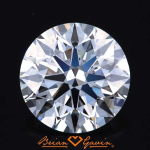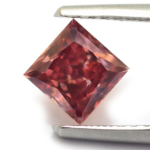What Are Eye-Clean Diamonds?
Diamond clarity is often confused with diamond brilliance. However, contrary to popular belief, investing in a higher clarity diamond like IF, VVS1 or VVS2 will not necessarily beget a beautifully sparkling stone. It is the cut of a diamond which determines light reflection and only in very rare cases does clarity affect transparency, therefore it is more appropriate to view diamond clarity solely as a rarity characteristic.
Diamond clarity is evaluated on the specific internal inclusions and external blemishes which are then further assessed on their relative location, orientation and overall visibility under 10x’s magnification. An easy way to think of this concept is the less inclusions/blemishes found in/on a polished diamond, the more rare the diamond and therefore the more expensive.
Should You Invest In a High Clarity Diamond?
Now that we understand clarity as a ‘rarity’ characteristic and not necessarily a beauty characteristic, how does one go about choosing an appropriate diamond for jewelry? Unfortunately, there are no hard and fast rules for diamond buying as each diamond is as unique as the individual purchasing it. However, it can be said that most individuals purchase a diamond as part of an engagement ring and aim to get the most for their money. As such, an eye-clean diamond is an appropriate guideline for most people as diamond carat weight and diamond color are visually more obvious to a layman’s eyes.
For example, it is easier to visually see the difference between a .75ct diamond and a 1.00ct diamond. Likewise, it is easier to visually see the difference between a ‘D’ colored diamond and a ‘J’ colored diamond. However, if you were to put an IF diamond next to a VS1 diamond, you would not be able to visually see the difference. Thus, eye-clean diamonds are the most economical choice and the easiest compromise to make when selecting a diamond.
What Is An Eye-Clean Diamond?

This 1.55ct H SI1 diamond is from Ritani and is perfectly eye-clean. Click the image for an HD video of this eye-clean diamond in motion.
An eye-clean diamond is an industry term used to describe a diamond that has no visible inclusions to the unaided eye. As all diamonds are graded with at least 10x’s magnification, a diamond with no visible inclusions is a perfect way to save cash while not compromising on visual appeal.
So how does a consumer go about finding an eye-clean diamond? Diamonds with clarity grades of VS1 and above do not have visible inclusions and are always visually clean. Diamonds with clarity grades of VS2 (most are eye-clean), SI1 (some are eye-clean), SI2 or I1 (few are eye-clean) clarity grades must be evaluated a little closer to determine if they have any visible inclusions. These are the clarity grades that will offer you greater value for money.
Please remember that each and every diamond is entirely unique and must be evaluated individually in all circumstances. One SI1 is not the same as another SI1. Keeping this in mind, there are some helpful tips that any newbie diamond buyer can benefit from knowing…
Eye-Clean Diamond Buying Tips:
Inclusions under the table facet – it’s generally better to find a diamond that does not have inclusions directly under the main table facet as this facet is the largest and is easiest to see through.
‘Crystals’ – are the most prevalent inclusion but not all crystals are equal. For example, a white/translucent or gray crystal is preferred over a dark/black crystal inclusion.
Twinning Wisps are often found in SI1 diamonds and are a great way to save cash as they are almost always impossible to see without magnification.
Small Scattered inclusions – are generally better than more concentrated inclusions. An example here would be multiple scattered white crystal inclusions vs. one concentrated dark crystal inclusion (both scenarios could potentially be an SI1 diamond).
Here is a perfect example of an eye-clean SI1 ideal cut diamond with tiny scattered white crystals and needles: https://www.ritani.com/diamonds/round-diamond-1-55-Carat-H-color-GIA-certified/D-1N25RJ
Diamonds with an I1 clarity grade often have visible inclusions however these diamonds are sometimes referred to as ‘prongable’ if an inclusion can be easily covered by a jewelry prong. Pay special attention to I1 or lower clarity grades as these can be more vulnerable to damage through wear and tear.
These are just general guidelines and are meant to be a further education on diamond clarity. By far the easiest way to determine clarity is to view the actual diamond in person or via magnified images and HD video if purchasing online.
Overall, diamonds with a lower clarity grades can offer tremendous value for money. Just remember, when it comes time to making your final decision on a diamond, always consult with a diamond or jewelry professional to ensure your diamond is visibly clean and not vulnerable to breakage.
(this post was originally published on Ritani’s blog: https://www.ritani.com/blog/diamonds/diamond-clarity-eye-clean-diamonds/)
Hey.You Want Ideal Cut Diamonds?
You've got it.
Join ODBA's Diamond Deal Friday and get handpicked diamonds every week from me to you.
No consultation required. Subscribe now!
ODBA Recommends
You May Also Like








